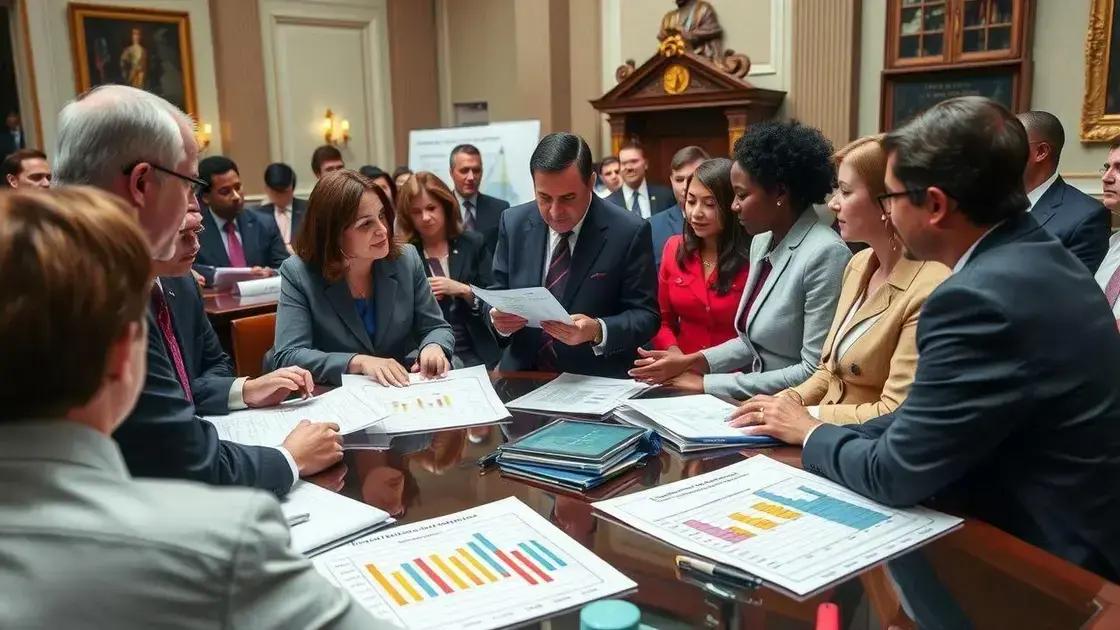Trump proposes changes to government worker classifications

Trump proposes changes to government worker classifications to create clearer job definitions and enhance accountability, aiming to improve job satisfaction and adapt to modern workforce needs.
Trump proposes changes to government worker classifications, stirring discussions across the nation. These proposed adjustments might significantly influence how federal jobs are structured and filled. Are you prepared to navigate this new landscape?
Understanding the proposed changes
Understanding the proposed changes to government worker classifications is essential for grasping the potential impact on federal employment. With these alterations, Trump aims to reshape how job functions are categorized and how employees roll into those categories. This shift might lead to various consequences for workers across the nation.
Key aspects of the proposed changes
The proposed changes focus on clarifying job roles, simplifying hiring processes, and increasing flexibility in hiring decisions. These adjustments are designed to address long-standing bureaucratic issues within federal employment.
- Clarification of job roles to align more with current needs.
- Streamlined hiring processes that promote efficiency.
- Enhanced flexibility allowing for quicker adaptations to workforce needs.
Moreover, the changes are expected to enhance government responsiveness. By revisiting how classifications are structured, Trump suggests that the federal government can better utilize its workforce and respond to public needs more effectively. This initiative has sparked both support and concern among various stakeholders.
Potential implications for federal employees
As these changes unfold, it’s important to consider how they may affect current federal employees. There is speculation that some positions may become more competitive, altering the landscape of job security. Employees might need to adapt to new roles or classifications. Some workers are eager to embrace these changes, hoping for career advancements, while others feel uncertain about their future.
Overall, these proposed changes are a pivotal part of a broader strategy to modernize government employment and make it more efficient. By engaging in open dialogue and considering feedback from various stakeholders, it is possible to navigate these shifts effectively.
Implications for federal employees
The proposed changes to government worker classifications hold significant implications for federal employees. With shifts in how jobs are defined, employees may need to adjust to new roles and responsibilities, leading to both opportunities and challenges in their careers.
Job security and competition
As roles become more clearly defined, the landscape of job competition is expected to change. Some positions may become more competitive, resulting in heightened pressure to perform. Employees might find themselves in a race to prove their value in a new classification system.
- Increased emphasis on qualifications and experience.
- Potential job security concerns for some roles.
- Opportunities for advancement in newly defined categories.
This increased competition could foster a sense of urgency among workers, pushing them to acquire new skills or certifications that align with the redefined job classifications. The adaptability of employees will be crucial in navigating this evolving job market.
Impact on work-life balance
Another aspect to consider is the impact of these changes on work-life balance. As job requirements shift, employees may face new expectations and demands. This can lead to increased stress levels as workers strive to meet evolving standards. Some may find that their work hours become less predictable, affecting personal time.
However, positive changes could also emerge. With clearer job roles, employees might enjoy greater job satisfaction as they find positions that better match their skills and interests. It’s essential to keep communication open between management and employees to ensure that transitions are smooth and that support systems are in place.
Understanding these implications will be critical for federal employees as they navigate the uncertain waters of government work classifications. The changes might foster a more dynamic and efficient federal workforce, but adaptability will be key.
Comparative analysis with past reforms

A comparative analysis of the proposed changes to government worker classifications with past reforms reveals significant insights. Looking back at prior attempts to modernize federal employment, we can understand the context and potential outcomes of these changes. Previous reforms often aimed to address similar issues, such as efficiency and job satisfaction, but met with varying degrees of success.
Overview of past reforms
In past decades, several major reforms tried to streamline processes in federal employment. Key initiatives included the National Performance Review in the 1990s, which aimed to make government more efficient. These reforms primarily focused on reducing bureaucracy but sometimes led to confusion among employees regarding their roles.
- Established performance evaluations to enhance accountability.
- Streamlined hiring processes to reduce delays.
- Tried to modernize job classifications but met resistance.
While these reforms had noble intentions, critics argue that they often fell short due to lack of proper implementation. Lessons learned from these initiatives could serve as a guide for current proposals, helping avoid pitfalls seen in the past.
Current proposals vs. past efforts
The latest proposals by Trump emphasize clarity and adaptability in job roles. Unlike previous reforms, which sometimes created ambiguity, the current focus on concrete classifications aims to prevent confusion and enhance efficiency. The intention is to not just change classifications but to improve overall employee satisfaction.
By analyzing how past reforms were received, it’s clear that communication and employee involvement are crucial. Employees often felt excluded from past decisions, leading to dissatisfaction and a lack of trust. Today’s proposals seek to include input from a wider array of voices, ensuring that employees feel heard and valued.
Understanding these historical contexts is vital for grasping the full impact of the proposed changes. By learning from history, the federal workforce can look toward a more organized and effective structure that promotes employee engagement and job satisfaction.
Public response and debates
The public response to the proposed changes in government worker classifications has sparked significant debate. Many citizens and federal employees are voicing their opinions on how these changes might reshape their work environment. As people learn more about these proposals, discussions are emerging regarding their potential benefits and drawbacks.
Mixed reactions
The reactions to these proposals are varied. Some employees express optimism, believing that clearer classifications will lead to better job stability and opportunities for advancement. They argue that clear job definitions can enhance worker satisfaction and productivity.
- Potential for improved job satisfaction.
- Increased clarity in job roles and expectations.
- Opportunities for professional growth through defined paths.
On the other hand, there are concerns and skepticism about the real impact of these changes. Critics worry that the new classifications may create unnecessary competition, making some positions less secure.
Role of unions and advocacy groups
Unions and advocacy groups play a significant role in shaping the conversation around these proposed changes. They are actively engaging in discussions with government officials to voice employee concerns and protect workers’ rights. By organizing meetings and rallies, these groups aim to influence the outcome of the proposals.
Many advocates emphasize the need for transparency in how these changes will be implemented. They argue that without clear communication, employees may feel vulnerable or confused about their future job security. Encouraging open dialogue between management and employees will be vital in creating a satisfactory outcome for all parties involved.
As debates continue, it is clear that public response to these proposals reflects a broader conversation about the future of work in government. The need for engagement from employees, unions, and community groups is essential to ensure that any new classifications serve the best interests of the workforce.
Future of government worker classifications
The future of government worker classifications is a topic of significant interest as proposed changes unfold. As organizations look to adapt to evolving workplace dynamics, the reclassification of federal jobs may play a crucial role in shaping federal employment. This change is more than just restructuring; it aims to create a workforce that is responsive and effective.
Potential enhancements in job structure
One of the goals of the new classifications is to enhance job structures within the federal workforce. By implementing clearer definitions of roles, the government hopes to foster a more efficient execution of tasks and responsibilities. This approach prioritizes accountability and employee engagement, which are essential for a high-functioning workforce.
- Clearer roles can lead to better accountability.
- Defined expectations may improve job performance.
- Increased employee engagement can enhance morale.
As the future unfolds, employees may benefit from pathways to advancement that are logically mapped out. This will allow them to understand how to reach higher positions and what steps are required in the process. Such clarity could motivate workers to pursue necessary skill development, ultimately benefiting the overall federal workforce.
Technological integration and flexibility
Another critical aspect of the future involves the integration of technology in the classification system. Embracing digital tools can enhance how federal roles are structured. With advancements in technology, job classifications can become more adaptable to changes in demand and public needs. This evolution paves the way for a workforce that is agile and ready to respond to various challenges.
Moreover, the focus on flexibility means that the government can swiftly adjust roles based on evolving job markets and public expectations. By creating a responsive structure, there is potential for the government to operate more like a dynamic organization instead of a rigid bureaucracy.
In summary, the future of government worker classifications holds the promise of a more structured and adaptable workforce. With a focus on clarity, accountability, and technological integration, federal employment can become more effective and satisfying for employees.
| 🔑 Key Points | 📋 Summary |
|---|---|
| Clearer Roles | Defining jobs helps everyone understand their responsibilities. |
| Increased Accountability | Better role definitions promote employee responsibility and accountability. |
| Technology Integration | Using tech solutions makes adapting to changes easier and quicker. |
| Employee Engagement | Involving employees in discussions helps shape a better work environment. |
| Future Readiness | These changes aim to prepare federal workforces for future needs. |
FAQ – Frequently Asked Questions about Government Worker Classifications
What are the proposed changes to government worker classifications?
The proposed changes aim to create clearer job definitions and enhance accountability within the federal workforce.
How will these changes benefit federal employees?
By making roles more defined, employees may experience greater job satisfaction, clearer expectations, and pathways for advancement.
What role does technology play in these new classifications?
Technology integration can help streamline processes and make job classifications more adaptable to changing public needs.
How can employees get involved in the discussion around these changes?
Employees are encouraged to participate in forums and discussions with management to voice their opinions and feedback regarding the proposed classifications.






